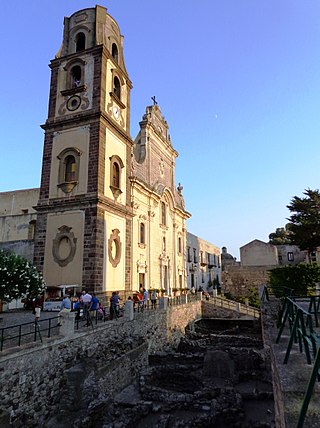
The Aeolian Islands, sometimes referred to as the Lipari Islands or Lipari group after their largest island, are a volcanic archipelago in the Tyrrhenian Sea north of Sicily, said to be named after Aeolus, the mythical ruler of the winds. The islands' inhabitants are known as Aeolians. The islands had a permanent population of 14,224 at the 2011 census; the latest official estimate is 15,419 as of 1 January 2019. The Aeolian Islands are a popular tourist destination in the summer and attract up to 600,000 visitors annually.

Lipari is a comune including six of seven islands of the Aeolian Islands and it is located in the Tyrrhenian Sea off the northern coast of Sicily, Southern Italy; it is administratively part of the Metropolitan City of Messina. Its population is 12,821, but during the May to September tourist season, the total population may reach up to 20,000. It is also the name of the biggest island in the archipelago, where the main urban area of the comune is located.

Vulcano or Vulcan is a small volcanic island belonging to Italy in the Tyrrhenian Sea, about 20 km (12 mi) north of Sicily and located at the southernmost end of the seven Aeolian Islands. The island is known for its volcanic activity and contains several volcanic calderas, including one of the four active volcanoes in Italy that are not submarine. The English word "volcano", and its equivalent in several European languages, derives from the name of this island, which derives from the Roman belief that the tiny island was the chimney of Vulcan, the Roman god of fire. In November 2021, 150 people were evacuated from the island's harbour area due to increased volcanic activity and gases; an amber alert had been issued in October 2021 after several significant changes in the volcano's parameters.

Stromboli is an island in the Tyrrhenian Sea, off the north coast of Sicily, containing Mount Stromboli, one of the four active volcanoes in Italy. It is one of the seven Aeolian Islands, a volcanic arc north of Sicily, and the mythological home of Aeolus.

The little ringed plover is a small plover. The genus name Charadrius is a Late Latin word for a yellowish bird mentioned in the fourth-century Vulgate. It derives from Ancient Greek kharadrios a bird found in river valleys. The specific dubius is Latin for doubtful, since Sonnerat, writing in 1776, thought this bird might be just a variant of common ringed plover.

The snailfishes or sea snails, are a family of marine ray-finned fishes. These fishes make up the Liparidae, a family classified within the order Scorpaeniformes.
Gnaeus Cornelius Scipio Asina was a Roman general and statesman who fought in the First Punic War.

Santa Marina Salina is a comune (municipality) and one of the main towns on Salina, one of the Aeolian Islands. It is situated in the Metropolitan City of Messina in the Italian region Sicily, located about 140 kilometres (87 mi) northeast of Palermo and about 70 kilometres (43 mi) northwest of Messina.

Liparis, commonly known as widelip orchids, sphinx orchids or 羊耳蒜属 is a cosmopolitan genus of more than 350 species of orchids in the family Orchidaceae. Plants in this genus are terrestrial, lithophytic or epiphytic herbs with a wide range of forms. The flowers are usually resupinate and small to medium sized, yellow, yellow-green or purplish with spreading sepals and petals. The labellum is usually larger than the sepals and petals and is lobed, sometimes with a toothed or wavy margin and one or two calli at its base.

Liparis loeselii, the fen orchid, yellow widelip orchid, or bog twayblade, is a species of orchid. It is native to Europe, northern Asia, the eastern United States, and eastern Canada. It grows in fens, bogs and dune slacks. It has yellow flowers and glossy yellow-green leaves.
- Liparis loeselii subsp. loeselii - Europe, Russia, Kazakhstan, Canada, United States
- Liparis loeselii subsp. orientalisEfimov - Altay region of Russia
- Liparis loeselii subsp. sachalinensis(Nakai) Efimov - Sakhalin Island in Russia

Liparis montagui, or Montagu's seasnail, is a marine fish of the seasnail family (Liparidae). It inhabits the northeastern Atlantic, mainly around the British Isles, the North Sea, the Norwegian Sea, southern Iceland and as far north as the Barents Sea. It is a small, demersal fish, usually living between from the intertidal zone to 30 metres deep, where it hides under stones or algae. It mainly feeds on small invertebrates, such as small crabs, shrimp and amphipods. This species was described in 1804 by the Anglo-Irish writer, natural history illustrator, and amateur zoologist Edward Donovan with England given as the type locality. The specific name honours the English naturalist George Montagu who provided Donovan with an illustration and a description of this "beautiful little fish".

Liparis fabricii, commonly known as the gelatinous seasnail or gelatinous snailfish, is a benthopelagic species of snailfish from the Arctic Ocean. It has a tadpole-like body with a maximum length of about 20 cm (7.9 in). It is brown to black in coloration with a distinctive dark peritoneum. It preys on small crustaceans and marine worms. It is not commercially important, though it is a valuable food source for predatory fish and seabirds in the Arctic region.

Liparis is a large genus of snailfish from the northern hemisphere. They are very common in temperate and cold waters. Chernova (2008) has proposed that the genus should be subdivided into five subgenera: Liparis, Neoliparis, Lycocara, Careliparis, and Lyoliparis.

Liparis liparis, the common seasnail, striped seasnail or seasnail, is a small species of marine ray-finned fish belonging to the family Liparidae, the snailfishes, in the order Scorpaeniformes, the scorpionfishes and flatheads. It is found in the northeastern Atlantic Ocean where it lives on the seabed.
The dubious conger is an eel in the family Congridae. It was described by Charles Marcus Breder Jr. in 1927, originally under the genus Pseudoxenomystax. It is a marine, deep water-dwelling eel which is known from the western Atlantic Ocean, including the United States, the Gulf of Mexico, Caribbean Sea, and the Guianas. It dwells at a depth range of 128–886 meters. Males can reach a maximum total length of 44.3 centimetres (1.45 ft) centimeters.

Mezitli River is a rivulet in Mersin Province, Turkey
Liparis zonatus is a fish from the genus Liparis. It may be found in the Northwest Pacific Ocean in the Yellow Sea, Dalian, and south Liao Dong Wan. The fish's depth ranges from 58 to 910 meters.

Liparis marmoratus, or the festive snailfish, is a marine ray-finned fish from the genus Liparis. It was first described by Schmidt in 1950.

Lipari Cathedral is a Roman Catholic cathedral in Lipari in the Province of Messina, Sicily, dedicated to Saint Bartholomew. Formerly the episcopal seat of the diocese of Lipari, it has been since 1986 a co-cathedral in the Archdiocese of Messina-Lipari-Santa Lucia del Mela.

Punta Lingua Lighthouse is an active lighthouse located on the south eastern tip of the island of Salina, which makes part of the Aeolian Islands, in the municipality of Santa Marina Salina on the Tyrrhenian Sea.














